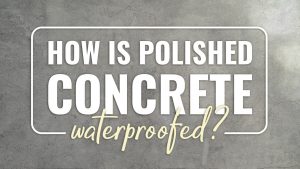Concrete is more often associated with strength and longevity than it is with beauty and design, but in polished concrete these worlds collide.
An ever more fashionable choice in houses of today, polished concrete can make for a beautiful feature, and turns your floor from boring to eye-catching. But there is an issue with using polished concrete on your floor, especially in certain areas of the house.
Concrete is porous by nature – as it cures, the chemical reaction generates air bubbles that slowly force their way to the surface. Many of these air bubbles remain trapped in the concrete when it fully sets, which can allow moisture – be it via humidity, precipitation, or in the case of a house, a leak or spill – to enter the slab.
This moisture can have an adverse on the concrete – cracking it, weakening it, and generating fungal growth. As such it’s vital that you waterproof your polished concrete in order to make it last longer.
How polished concrete is waterproofed.
Because of aesthetic restrictions, waterproofing polished concrete is difficult. The desirable polished concrete look comes from buffing down pure concrete, and adding a waterproofing spray or membrane can ruin this look. Indeed, in areas such as the kitchen or bathroom such a membrane can pose a serious slip risk.
Instead, polished concrete waterproofing is most commonly achieved by curing two separate slabs and placing a waterproof membrane in between.
The foundation slab is poured first, and once cured is coated with a waterproof membrane. The second slab is then poured and cured on top, and before bring polished up as per usual. While this still exposes the top slab to the effects of moisture, it minimises the work of replacing the slab and creates a safer surface to walk on in wet areas.
Membranes are constantly being improved, so it may not be long before we see a membrane that is appropriate for application on the exposed polished concrete. But until that point, a two slab approach is the best bet for your house’s wet areas.


